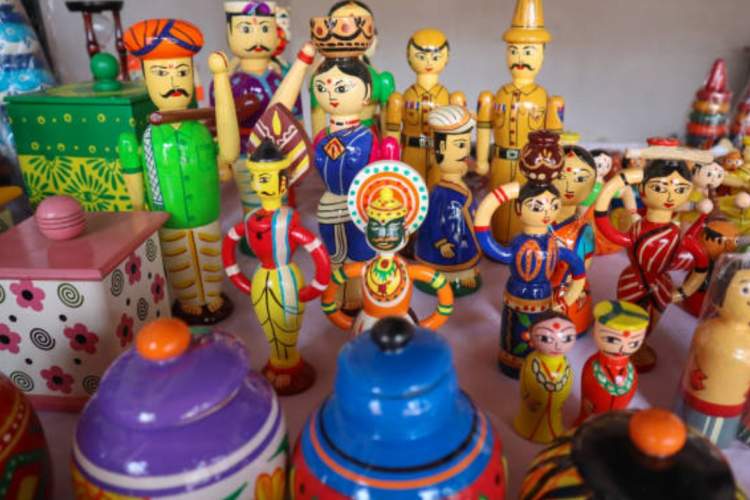
India’s toy industry has quietly undergone a revival under the Make in India umbrella. Once defined by high import dependence, the sector is now asserting an export surplus—a testament to both policy intent and emerging indigenous capability. Between 2018–19 and 2021–22, toy exports surged from $109 million to $177 million, even as imports declined sharply from $371 million to $110 million. But within this quantitative uptick, artisan crafts such as Etikoppaka and Kondapalli continue to epitomise deeper values—heritage, sustainability, rural livelihoods—where commerce, culture, and policy intersect.
On the banks of the Varaha River sits Etikoppaka village, where a 400yearold lacquered toy tradition thrives. Carved from soft Ankudu (Wrightia tinctoria) and coloured with plant-derived dyes—turmeric, indigo, bark, seeds—and sealed using lac, these toys are nontoxic, biodegradable and timeless.
READ | EMIs and aspiration: India’s household debt story explained
The tradition has found a stage on the nation’s grandest cultural platform: the Republic Day Parade of 2025. This marks the fourth consecutive year Andhra Pradesh has featured its heritage arts on the Kartavya Path. The state tableau, under the theme “Etikoppaka Bommalu,” included a dramatic 14foot Lord Vinayaka, mythological figures, spinningtop scenes, and artisans at work, accompanied by a bespoke soundtrack. Around the same time, artisans displayed their craft at the Vividhta Ka Amrit Mahotsav held at Rashtrapati Bhavan, where President Murmu personally interacted with Sarath, an Etikoppaka artisan, underscoring the tradition’s symbolism and national resonance.
Kondapalli: A Creative-Economic Hub in the Making
Just 200 km away lies Kondapalli—home to Tella Ponikiwood toys, assembled with natural adhesive (makku) and painted in vivid vegetable and enamel hues, depicting myth, rural life, and Dasavataram sets. Recognised with a GI tag in 2007, this craft remains integral to festive displays like Bommala Koluvu during Sankranti and Navaratri.
In a timely policy turn, the NTR district administration has embarked on converting Kondapalli into a “rural creative economic hub.” A Kondapalli Bommala Experience Centre is under construction—designed as a living museum with guided tours, artisan demonstrations, murals, and immersive branding, spearheaded by local authorities in partnership with the Andhra Pradesh Tourism Authority and the Young Indians, Amaravati chapter.
Current Affairs Usthadian Academy. This initiative signals a shift from recognition to experiential infrastructure, aiming to blend heritage, youth entrepreneurship, and tourism into a sustainable growth model.
Behind the scenes, innovation and design are helping stretch the lifeline of these crafts. C.V. Raju, the Padma Shriwinning Etikoppaka innovator, has not only revived naturaldye techniques but also formed a cooperative of 160 artisans producing some 30,000 toys monthly, achieving shelfstable finishes and international reach. Meanwhile, Andhra designers such as Umamaheswara Rao are offering free design services and mentorship to artisans across Etikoppaka, Kondapalli, and Nirmal communities—bridging tradition and contemporary markets.
Yet awareness remains a challenge. A recent AIIMS Bhopal study found that only 64 percent of parents even consider environmental impact when buying toys for children under five—price, durability, safety and visual appeal still dominate decisionmaking. If handcrafted, eco-friendly toys are to move from niche to mainstream, awareness campaigns must parallel capacity building.
Towards Resilient, Identity-Driven Policy
Etikoppaka and Kondapalli are not mere crafts—they are vectors of rural livelihood, women’s and youth agency, green entrepreneurship, and cultural identity. But preserving them requires concerted policy architecture: sustainable supply chains (such as reforestation of Ankudu and Poniki), design upskilling, quality certification, digital marketing, tourism-craft linkages, and export promotion.
With India negotiating trade accords such as the UK-India FTA, GI-tagged traditional toys can be flagged as strategic sectors. Tariff concessions, regulatory facilitation, digital catalogues, export incentives, and soft-power branding would enable artisans to connect with ethically conscious consumers in the UK, Europe, and beyond. Both states and central government should frame GI-tagged toys as flagship cultural exports—backed not only by nostalgia, but by ecological integrity, artisanal craftsmanship, and rural resilience. These are not just “toys”; they are living, breathing narratives of identity and sustainability.
In Etikoppaka and Kondapalli, India confronts its future not merely through productivity, but through persistence of craft. As the world debates automation and scale, these 400-year-old art forms remind us that the most resilient economies often grow from soil-to-story linkages—of culture, craft, and identity—hand in hand with commerce.
Dr Oly Mishra is a faculty member at the Indian Institute of Foreign Trade (IIFT), New Delhi. Her research interests in sustainability, cultural entrepreneurship, and consumer behaviour.
